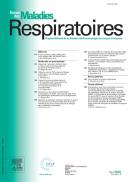Manifestations respiratoires des syndromes d’Ehlers-Danlos - 22/03/23
Respiratory manifestations of Ehlers-Danlos syndromes
 , K. Benistan b, c, M. Frank d, e, S. Boussouar f, g
, K. Benistan b, c, M. Frank d, e, S. Boussouar f, gRésumé |
Les syndromes d’Ehlers-Danlos (SED) sont un groupe hétérogène de maladies héréditaires rares du tissu conjonctif caractérisées par la triade clinique hyperlaxité articulaire, hyperélasticité cutanée et fragilité tissulaire. Les manifestations respiratoires associées aux SED sont fréquentes et variées. Elles dépendent principalement du type de SED. Dans les SED non vasculaires (SEDnv), hypermobile et classique, la dyspnée est un symptôme fréquent. Ses étiologies sont larges et peuvent être associées chez un même patient : asthme, faiblesse des muscles respiratoires, déformation de la cage thoracique, collapsus des voies aériennes supérieures et inférieures. La prévalence du syndrome d’apnées obstructives du sommeil est élevée dans les SEDnv. Dans le SED vasculaire (SEDv), les complications pulmonaires sont dominées par le pneumothorax, l’hémothorax et les hémoptysies. Elles précèdent souvent le diagnostic de SEDv de plusieurs années. Il est donc impératif de rechercher des arguments en faveur d’un SEDv devant tout pneumothorax ou hémothorax spontané chez un jeune patient. La présence d’anomalies scanographiques parenchymateuses évocatrices (emphysème, clusters de nodules calcifiés, nodule excavé) peut être une aide au diagnostic. Une meilleure connaissance des atteintes pulmonaires des SED par la communauté pneumologique permettrait d’améliorer la prise en charge des malades et d’ouvrir la voie à des travaux de recherche.
Le texte complet de cet article est disponible en PDF.Summary |
Ehlers-Danlos syndromes (EDS) represent a heterogeneous group of heritable connective tissue disorders characterized by the clinical “triad” consisting in joint hypermobility, skin hyperextensibility and tissue fragility. Respiratory manifestations associated with EDS are frequent and variable. They vary mainly according to the type of EDS. In hypermobile and classical EDS, the most frequent non-vascular types, dyspnea is a common symptom. Its etiologies are wide-ranging and can coexist in the same patient: asthma, respiratory muscle weakness, chest wall abnormalities, upper and lower airway collapse. The prevalence of obstructive sleep apnea syndrome in nvEDS is high. Identification of the relevant dyspnea mechanism is essential to providing appropriate therapeutic measures. In vascular EDS (vEDS), the main pulmonary complications are pneumothorax, hemothorax and hemoptysis. As they frequently precede the diagnosis of vEDS by several years, it is imperative to raise the possibility of vEDS in a young patient with spontaneous pneumothorax or hemothorax. The presence of suggestive computed tomography parenchymal abnormalities (emphysema, clusters of calcified nodules, cavitated nodule) can be an aid to diagnosis. Treatment is based on the usual approaches, which must be carried out with caution by an experienced operator fully informed of the diagnosis. Better knowledge of respiratory manifestations of EDS by the pneumological community would improve patient care and pave the way for further research.
Le texte complet de cet article est disponible en PDF.Mots clés : Syndromes d’Ehlers-Danlos, Respiration, Dyspnée, Fonction respiratoire, Pneumothorax
Keywords : Ehlers-Danlos syndrome, Respiratory, Dyspnea, Pulmonary function, Pneumothorax
Plan
Vol 40 - N° 3
P. 254-264 - mars 2023 Retour au numéroBienvenue sur EM-consulte, la référence des professionnels de santé.

